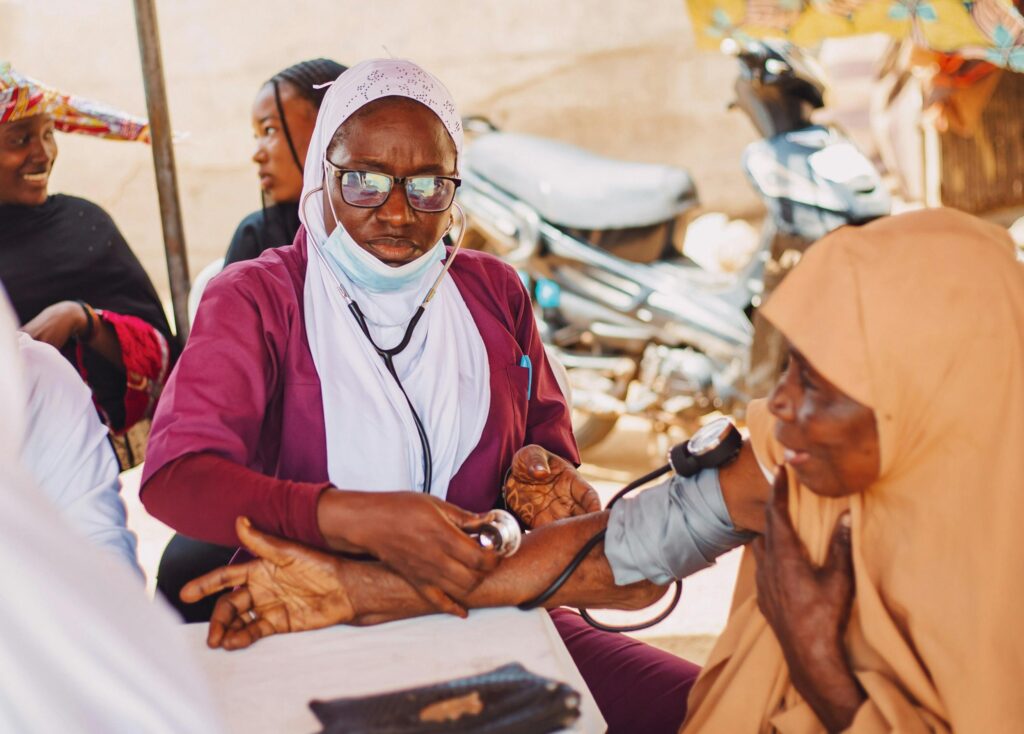
Background
Ghana is experiencing an alarming rise in non-communicable diseases (NCDs). Digital health — when governed, designed, and implemented well — can dramatically improve early screening and case identification, strengthen assessment and diagnosis, support evidence-based management, and keep patients engaged through long-term follow-up. This post explains how digital health fits across the NCD care continuum, grounds those suggestions in Ghana’s policy environment, cites established digital solutions (including DPGA-recognized platforms such as Medtronic LABS’ SPICE), and gives explicit, actionable recommendations for the Ministry of Health (MOH) and Ghana Health Service (GHS). Importantly: MOH/GHS should enable — not crowd out — private sector and NGO actors; where private/NGO partners run robust digital systems, the priority is interoperability with national data systems and partnership, not replacement.
Why this matters now
Recent reporting from Korle Bu Teaching Hospital highlights the scale and urgency of Ghana’s NCD challenge: the hospital recorded more than 5,000 complicated diabetes referrals and over 2,000 kidney cases in the first half of 2025 — a clear signal that detection and continuity of care must improve nationwide. GBC Ghana Online
Ghana already has the policy scaffolding to act: the National Policy: Non-Communicable Diseases (2022) and the Policy & Strategy on Digital Health (2023–2027) together commit the country to strengthen screening, health system capacity, data governance and interoperability — but turning strategy into outcomes requires careful coordination, financing and public-private partnership. Ministry Of Health+1
How digital health strengthens each stage of the NCD care continuum
Below we describe the concrete digital interventions that improve outcomes from screening through long-term follow-up, and point to evidence or country practice where available.
Screening & case identification — find people earlier, where they live

What’s needed: low-cost, scalable outreach that reaches people outside hospitals (markets, workplaces, CHPS zones) and prompts confirmatory testing when appropriate.
Digital levers:
- SMS/IVR campaigns and phone-based risk assessments for mass triage (works on feature phones).
- CHW/CHPS tablet & mobile apps for door-to-door or outreach screening that register people into longitudinal systems.
- Community screening events with instant digital enrolment so suspected cases are tracked for confirmatory testing and referral.
- Geospatial dashboards to identify underserved “hot spots” and target campaigns.
NCD Policy — on screening & CHPS
“This policy seeks to establish screening services to contribute to the reduction of NCDs morbidity and mortality through the implementation of national guidelines for screening, the establishment of wellness clinics and the strengthening of the capacity of the Community-based Health Planning and Services (CHPS) to provide screening services.” Ministry Of Health
What success looks like: more NCDs identified at primary care and community level (reduced late referrals to secondary and tertiary hospitals), and routine capture of those screened into an electronic registry so they can be followed up.
Assessment & diagnosis — bring the right tests to the right patients

What’s needed: confirmatory tests (HbA1c, creatinine/albumin for kidney disease), standardized assessments, and timely specialist input for complex cases.
Digital levers:
- DHIS2 Tracker / E-Tracker modules or interoperable EHRs that record assessment results and generate clinical flags.
- Connected point-of-care devices (glucometers, POC creatinine) that auto-upload into patient records.
- Teleconsultation links to specialists (endocrinology, nephrology) for case review and referral triage.
Why this matters in Ghana: the GHS / WHO reporting and DHIS2 experience indicate active work to deploy E-Tracker modules for NCDs so individual-level data can be captured for monitoring and clinical follow-up. DHIS2 Tracker (E-Tracker) is an appropriate national standard to host or aggregate these records. WHO | Regional Office for Africa+1
Management & treatment — support clinicians and patients with tools that improve outcomes

What’s needed: guideline-driven care, medication adherence support, and patient education at scale.
Digital levers:
- Clinical decision support integrated into electronic records to prompt guideline-based prescribing and complication screening.
- mHealth apps, SMS or IVR for appointment reminders, medication adherence, lifestyle coaching and self-management.
- Remote monitoring (Bluetooth BP cuffs, glucometers) for high-risk patients with data flowing back to care teams or CHWs.
- Case management workflows that allow CHWs, nurses and clinicians to coordinate care across community and facility.
Evidence & product example: scalable, programmatic platforms that combine community screening, clinician review, and longitudinal tracking—such as Medtronic LABS’ SPICE platform—are designed specifically for community-based NCD management and are recognized as open, interoperable digital public goods (Digital Public Good Alliance). SPICE also implements WHO-aligned clinical algorithms (e.g., WHO HEARTS) in its workflows for risk stratification and treatment planning. Where such platforms exist, MOH/GHS should enable their integration with national systems rather than attempting to replace them. Investing News Network (INN)+1
Follow-up & long-term monitoring — prevent complications, reduce hospitalizations

What’s needed: systems that keep patients retained in care, detect deterioration early, and schedule timely screening for complications (eyes, kidneys).
Digital levers:
- Electronic patient registries with automated follow-up schedules, missed-visit flags and SMS/IVR outreach.
- Risk-stratification analytics to prioritise patients for home visits or in-person review.
- CHW workflows and lists generated from the national registry so community follow-up is targeted and data are captured centrally.
What success looks like: higher retention in care for cohorts enrolled in digital-enabled programs, fewer emergency/late presentations, and measurable reductions in complication rates over time.
Key barriers (Ghana context)
- Infrastructure: power and mobile data gaps in rural areas hinder real-time syncing and device use.
- Human resources & digital skills: a large share of frontline workers need targeted training on digital tools and clinical workflows.
- Fragmented systems & limited interoperability: multiple legacy systems with limited connections increase duplication and loss of longitudinal patient data.
- Sustainability & financing: many pilots rely on donor funding; scale requires predictable government or pooled financing.
- Equity risk: without design for feature phones and low literacy, digital programs can widen inequalities.
Evidence about limited interoperability in Ghana’s health data ecosystem has been documented and is specifically called out in national HIS and digital health reviews. ResearchGate
Ghana’s National Policy: Non-Communicable Diseases (2022):
“This policy seeks to establish screening services to contribute to the reduction of NCDs morbidity and mortality through the implementation of national guidelines for screening, the establishment of wellness clinics and the strengthening of the capacity of the Community-based Health Planning and Services (CHPS) to provide screening services.” Ministry Of Health
“…in line with the Government’s ‘Ghana beyond aid’ agenda there is the need to explore innovative ways for funding NCDs prevention and control activities. This will be done in line with domestic, bilateral and multilateral funding mechanisms and within the current health financing arrangements. The policy will advocate for earmarked funds and increased budgetary allocations for NCDs.” Ministry Of Health
“The population will be empowered and supported to proactively take measures to adopt healthy lifestyles… abstinence from alcohol or moderation in alcohol consumption will be encouraged and promoted…” Ministry Of Health
Ghana Policy & Strategy on Digital Health (2023–2027):
“Develop and operationalise interoperability frameworks, standards, and guidelines for digital health platforms; and monitor interoperability, and ensure compliance with standards and guidelines.” WHO Extranet
“…strengthening governance and accountability structures for digital health across various administrative levels to ensure client safety, data security, confidentiality, privacy and a competent health workforce proficient in digital technologies.” WHO Extranet
Recommendations for MOH & GHS

Core principle: MOH and GHS must enable, coordinate and regulate, not crowd out. NGOs and private sector actors should be treated as partners and complementary service providers, particularly where they bring proven, robust digital health platforms. The MOH/GHS role is to insist on interoperability with national systems and strong data governance so that private/NGO innovation strengthens the public good (continuity of care, surveillance, planning).
Make interoperability and data governance the non-negotiable baseline
- Mandate open standards, APIs and data dictionaries so private/NGO platforms can exchange data with national systems (E-Tracker / DHIS2) in real time or near-real time.
- Require formal data-sharing agreements that protect patient privacy (consent mechanisms, encryption, audit logs). The Digital Health Strategy already calls for operationalised interoperability and governance frameworks — MOH/GHS should prioritise implementation and enforcement.
Do not crowd out private/NGO innovators — actively partner with them
Where NGOs or private firms operate robust platforms (for example, DPGA-recognized platforms such as Medtronic LABS’ SPICE), MOH/GHS should not force them to abandon those investments. Instead:
(a) certify/interoperate those platforms with national systems
(b) create contracting frameworks that define roles/responsibilities, and
(c) recognise NGOs as complementary implementers in national plans.
SPICE is an example of an open, standards-oriented platform built to integrate with government systems and implement WHO-aligned algorithms. Investing News Network (INN)+1
Accelerate unique patient identifiers & master facility registries
Issue and operationalise a national unique patient identifier usable across public and private sectors, and ensure a master facility registry that includes private and NGO facilities for linking records and referrals. This is foundational for continuity of care and accurate national surveillance. WHO | Regional Office for Africa
Scale the E-Tracker / DHIS2 approach & open APIs
Finalise national roll-out plans for NCD modules in the DHIS2 E-Tracker and publish standardized data elements and APIs so private/NGO platforms can synchronise records (while retaining their service layer). The DHIS2 Tracker is well-suited for capturing longitudinal NCD data and managing cohorts. DHIS2+1
Invest in workforce capacity & inclusive design
- Fund digital health training in preservice curricula and provide continuing professional development for frontline workers.
- Require developers to design for feature phones, local languages and low literacy; deploy CHWs as the bridge to reach underserved communities.
Finance for scale & sustainability
- Create budget lines for digital NCD programs and consider subsidies for home monitoring devices for low-income patients.
- Explore NHIS reimbursement for validated telehealth and follow-up services to create sustainable revenue models for partners.
Monitoring, evaluation & evidence-led scale-up
Require clinical and economic evaluation of pilots before national procurement; prioritise programs that demonstrate improved retention, better control of risk factors, and cost-effectiveness. Use evidence to guide procurement and scale decisions.
Governance & coordination
Convene a permanent multi-stakeholder digital health coordination forum (MOH, GHS, NHIA, private sector, NGOs, academia) with clear decision rights over standards, certification and scale-up sequencing.
Example: how MOH/GHS can integrate a robust private/NGO platform
- Publish an interoperability spec for NCD data (minimum dataset, message formats, consent model).
- Offer a fast-track interoperability certification for any platform that demonstrates compliance (so SPICE-type platforms can be integrated quickly).
- Pilot two-way syncing in selected districts: NGO/Private platform ↔ E-Tracker (DHIS2) with joint monitoring.
- Use results to define national roll-out and procurement frameworks that specify roles (MOH = steward/regulator; NGOs = implementers/innovators).
What success looks like — suggested measurable targets
- National E-Tracker coverage for NCD encounters in tertiary + regional hospitals within 24 months, with phased district roll-out. WHO | Regional Office for Africa
- Interoperability certification process completed and at least five private/NGO platforms integrated into the national system within year 1.
- Measurable increase in early case detection at primary/community levels and improved retention (target: digital-supported cohort retention ≥75% at 12 months).
- Reduction in late tertiary referrals for complications (tracked via DHIS2 aggregated dashboards).
Conclusion — partnership, standards, scale

Ghana already has strong policy language in the National NCD Policy and the Digital Health Strategy that supports screening, health system strengthening, interoperability and governance. The immediate priority is not to duplicate or seize private/NGO capabilities, but to create rules of the road: require interoperability, protect data, incentivise partnerships, and finance scale. Where private/NGO platforms (for example DPGA-recognized solutions such as Medtronic LABS’ SPICE) bring tested, WHO-aligned workflows and strong local deployment capacity, MOH/GHS should integrate and partner — making sure these solutions exchange data with national systems so patient care and national planning both benefit. Ministry Of Health+2WHO Extranet+2
Tidex Scientific Group stands ready to help design interoperable digital programs, draft API/data-sharing templates, and support evaluation frameworks to ensure Ghana’s digital investments bend the curve on NCDs.
